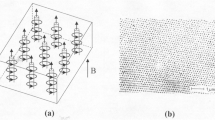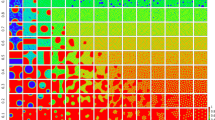Experimental evidence for flux-line cutting in superconductors (intersection and cross-joining of singly quantized vortices) is briefly reviewed. The interaction energy between two straight vortices tilted at an angle α (≠ 0)is then shown to be finite in the London model, i.e., in the limit of vanishing core radius. Next, the activation energy and maximum interaction force are calculated for the vortices in an analytic approximation to the Ginzburg-Landau theory. Here two competing interactions determine the behavior. Electromagnetic repulsion (0 < α < π/2) varies as cos α and decays over distances scaled by the penetration depth λ, while core attraction is independent of α and varies over distances scaled by the coherence length ξ. The force is always repulsive at large flux-line separation (0 < α < π/2) and its maximum decreases rapidly as κ decreases, so that flux-line cutting isexpected to be more probable in low-κ materials. The calculations provide a basis for explaining longitudinal flux-flow resistance as well as some intriguing magnetization behavior in the same configuration.
Similar content being viewed by others
References
A. A. Abrikosov, Zh. Eksp. Teor. Fiz. 32, 1442 (1957); [Sov. Phys.-JETP 5, 1174 (1957)].
P. W. Anderson and Y. B. Kim, Rev. Mod. Phys. 36, 39 (1964).
H. London and D. G. Walmsley, in Proceedings 11th Int. Conf. Low Temp. Phys. (St. Andrews, 1968), p. 879.
K. Yasukochi, T. Ogasawara, Y. Kubota, and K. Maryuama, in Proceedings 12th Int. Conf. Low Temp. Phys. (Academic Press of Japan, Kyoto, Japan, 1970), p. 178.
D. G. Walmsley, J. Phys. F 2, 510 (1972).
D. G. Walmsley and W. E. Timms, J. Phys. F 3, L203 (1973).
J. F. Nicholson and P. T. Sikora, J. Low Temp. Phys. 17, 275 (1974).
T. Ezaki and F. Irie, J. Phys. Soc. Japan 40, 382 (1976).
W. E. Timms and D. G. Walmsley, J. Phys. F 6, 2107 (1976).
D. G. Walmsley and W. E. Timms, J. Phys. F 7, 2373 (1977).
C. J. Bergeron, Appl. Phys. Lett. 3, 63 (1963).
A. M. Campbell and J. E. Evetts, Adv. Phys. 21, 199 (1972).
J. R. Clem, Phys. Lett. 54A, 452 (1975).
J. R. Clem, Phys. Rev. Lett. 38, 1425 (1977).
J. R. Cave, Ph.D. Thesis, University of Cambridge (1978), unpublished.
J. R. Cave and J. E. Evetts, Phil. Mag. B 37, 111 (1978).
B. Makiej, A. Sikora, S. Golab, and W. Zacharko, in International Discussion Meeting on Flux Pinning in Superconductors (Akademie der Wissenschaften in Göttingen, Sonnenberg, 1974), p. 305.
B. Makiej, S. Golab, A. Sikora, E. Trojnar, and W. Zacharko, in Proceedings 14th Int. Conf. Low Temp. Phys. (North-Holland, Amsterdam, 1975), Vol. 2, p. 141.
B. D. Josephson, Phys. Rev. 152, 211 (1966).
W. E. Timms and D. G. Walmsley, Phys. Stat. Sol. (b) 71, 741 (1975).
E. H. Brandt, J. Low Temp. Phys. 26, 735 (1977).
L. Kramer, Phys. Rev. B 3, 3821 (1971).
J. R. Clem, J. Low Temp. Phys. 18, 427 (1974).
J. R. Clem, in Proceedings 14th Int. Conf. Low Temp. Phys. (North-Holland, Amsterdam, 1975), Vol. 2, p. 285.
E. H. Brandt, J. Low Temp. Phys. 28, 263, 291 (1977).
E. H. Brandt, J. Low Temp. Phys. 26, 709 (1977).
Author information
Authors and Affiliations
Additional information
This work was supported by the U.S. Department of Energy, Office of Basic Energy Sciences, Materials Sciences Division, and by the Deutsche Forschungsgemeinschaft.
On leave from Max-Planck-Institut für Metallforschung, Institut für Physik, Stuttgart, West Germany.
On leave from New University of Ulster, Coleraine, Northern Ireland.
Rights and permissions
About this article
Cite this article
Brandt, E.H., Clem, J.R. & Walmsley, D.G. Flux-line cutting in type II superconductors. J Low Temp Phys 37, 43–55 (1979). https://doi.org/10.1007/BF00114055
Received:
Issue Date:
DOI: https://doi.org/10.1007/BF00114055




